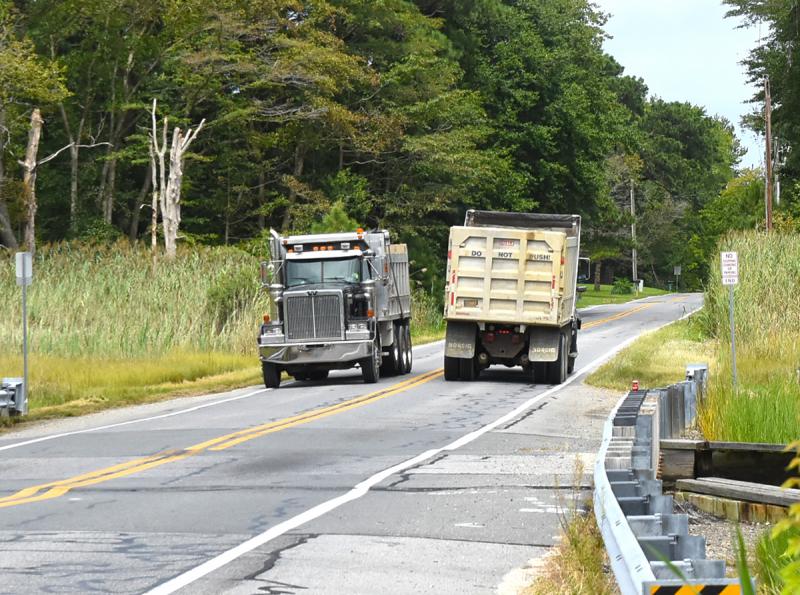During a recent visit to Lewes, U.S. Sen. Tom Carper stood next to the Canary Creek bridge on New Road discussing a federal funding for flood-prone areas. As he spoke, dozens of dump trucks traveled to and from Lewes, nearly drowning out Carper’s words.
The trucks were heading to Harbor Point, a 69-unit single-family home major subdivision along the Great Marsh, where site work is underway.
“There was more than a little irony during his visit,” said Doug Spelman, president of the Canary Creek homeowners association, a development that borders Harbor Point. “As the senator was explaining the need for federal dollars to supplement the infrastructure needs of the state and county, there was a continuous parade of large tandem-wheeled dump trucks pounding the pavement and further damaging the very bridge that was the symbol of infrastructure need in Sussex County.”
For several weeks, dozens of trucks have streamed up and down New Road, hauling fill dirt to the Harbor View site.
“They start early,” said Greg Pearsall, who lives in the Tradewinds community along New Road. “I can hear each one coming from inside the house, and they keep up a fairly steady stream, about every one to two minutes. Most appear to follow the speed limit, but there are some who really blow by.”
During a 15-minute stretch Sept. 4, 18 dump trucks came and went from the site. The next day, 30 trucks came and went during a 30-minute period.
Area residents say they are worried about the integrity of New Road and the Canary Creek bridge.
In response to the increased truck traffic, Delaware Department of Transportation recently sent a team to inspect the bridge, said Charles McLeod, DelDOT’s director of community relations.
The inspectors found no damage or distress to the bridge, he said, but the roadway near the bridge shows damage.
“There is settling on the approaches to the bridge that is creating unevenness and causing a bump,” he said. “We are going to be putting some additional asphalt down on those areas in October to smooth out the transition from the road to the bridge.”
The cost will not be covered by the developer, he said. It is part of general maintenance work on the roadway.
Harbor Point, approved for 69 units on 108 acres, was originally filed in Sussex County in April 2013. It was withdrawn when Lewes officials expressed interest in the project. The developer then worked with Lewes officials on possible annexation, but later opted to withdraw and resubmit the plan to Sussex County. It was approved by the county’s planning and zoning commission in March 2015.
In conditions proffered by then-planning and zoning commissioner Irwin “I.G.” Burton III, basements will be prohibited and all houses must be built one foot above the base-line flood level determined by the Federal Emergency Management Agency.
Jessica Watson, program manager at Sussex Conservation District, said her organization has jurisdiction on sediment and erosion control, and stormwater management.
“There is significant fill proposed for the development, but I don’t have the cut/fill totals for the project,” she said.
She said the amount of fill going on a site is not something her organization deals with. Instead, she said, the Sussex Conservation District reviews the plans to ensure water is being directed to a stormwater facility and that it is properly treated before being discharged. During the construction phase, she said, they require developers to minimize sediment and erosion. At Harbor Point, she said, they required a super silt fence – silt fence and chain-link fence – due to the proximity to sensitive areas including the Great Marsh.
Like much of Lewes, most of the Harbor Point development is within a special flood hazard area, according to FEMA maps. Per Sussex County Code, fill is permitted in that area for the purpose of raising the ground level and to support a building if it meets certain requirements. If the project was in a coastal high-hazard area – areas along the coast susceptible to wave velocity – structural fill to elevate buildings would have been prohibited.
Lewes’ zoning ordinance allows fill within a floodplain, but not for foundations.
Sussex County’s floodplain administrator, Jeff Shockley, did not respond to a request for comment. However, Lewes’ Planning and Developer Officer Tom West has experience with the process. The review and control for placing fill is defined by FEMA’s Letter of Map Revision process, he said, and applicants and the local jurisdiction are involved in that review process. Lewes Building Department Manager Robin Davis is the city’s floodplain administrator.
Whether fill going to the property is legal or not, residents are concerned about the trucks.
“Those trucks have definitely changed the nature of the quiet country road and are destroying it at the same time,” Pearsall said. “I just hope the bridge holds up to the onslaught.”






















































